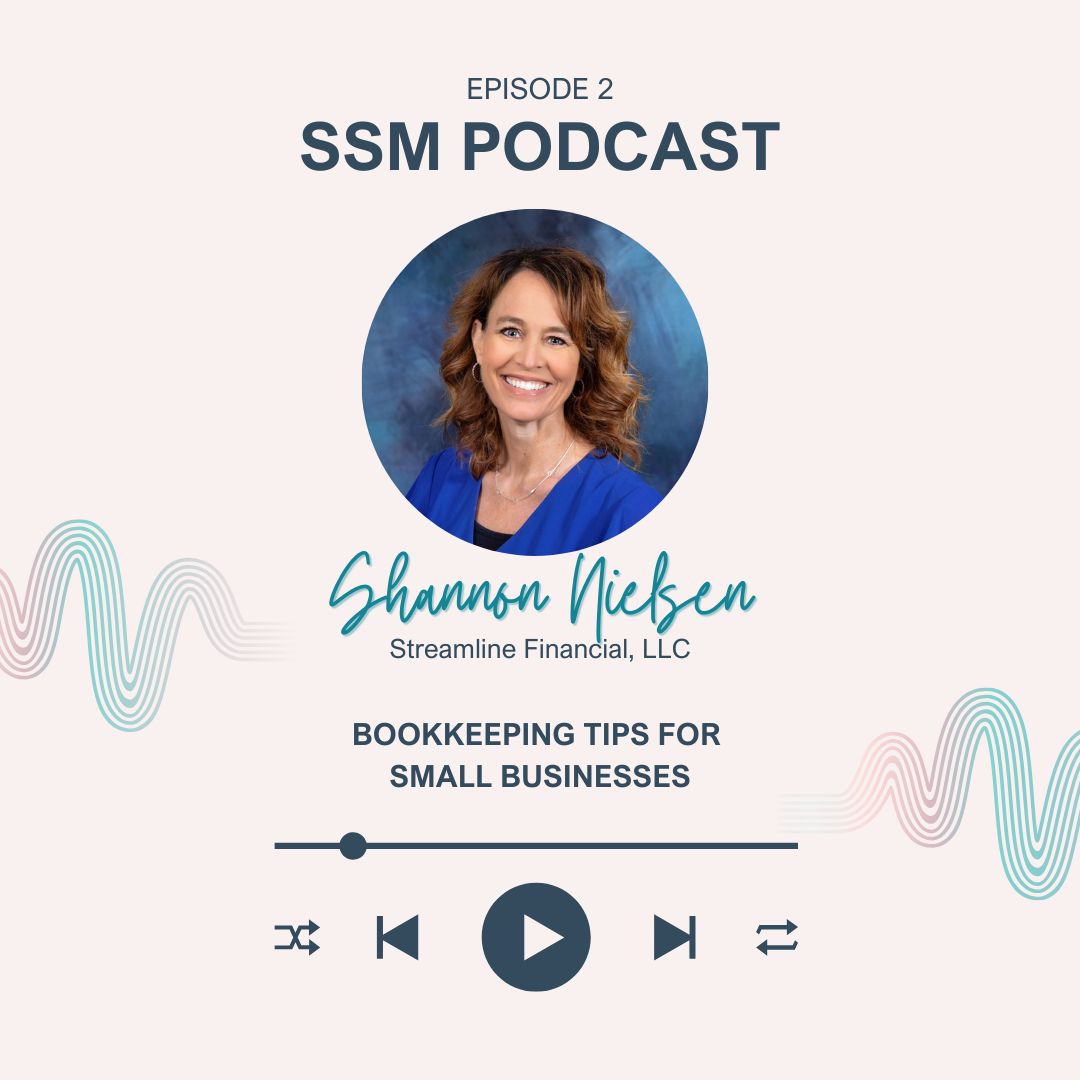Going from “I think we’re okay?” to “I know where every dollar’s going”
“Most small business owners love what they’re doing, but they have no idea if they’re even making any money.” – Shannon Nielsen, Streamline Financial
You started your business to do what you love—not to drown in numbers. In this quick guide, pulled from our Small Business Podcast chat with Shannon, we’ll show you the simple, zero-fluff habits that keep your books clean, your taxes surprise-free, and your decisions confident.
You’ll learn how to separate business and personal the right way, what to track (and how to track it without wasting hours), the must-have banking features that actually help, and how much to set aside for taxes so April doesn’t sting. We’ll keep it practical, beginner-friendly, and totally DIY-able—and yes, there’s a free, plug-and-play spreadsheet at the end to make it even easier.
Section 1: Keep Personal and Business Finances Separate
It sounds simple, but it’s one of the biggest mistakes new business owners make—mixing personal and business money. Shannon put it plainly: “It’s a layer of protection… the IRS will recognize you as a business because you can show these are all business expenses.”
Even if you don’t have an EIN yet, open a separate bank account just for your business. Run every expense and deposit through that account, and transfer money to your personal account when you need to pay yourself.
Why does this matter so much? Two reasons:
- Protection. If your accounts are mixed and you’re ever audited or sued, you could lose the “shield” between your business and your personal assets.
- Professionalism. Clear records show you’re running a real business, which matters when you apply for loans, line up investors, or one day decide to sell.
Shannon summed it up best: “At some point you probably want to sell your business. Having clean, separate records shows a history of growth and good financial health.”
👉 If this feels overwhelming, this is exactly where Shannon and her team at Streamline Financial step in. They help small businesses set up clean systems from the start—so you can focus on the work you love instead of stressing about the IRS.
Section 2: Track and Organize Your Receipts
Shoeboxes full of crumpled paper? That’s old-school stress you don’t need. These days, bookkeeping is way easier thanks to tools you already have in your pocket – your phone.
Shannon’s advice: “If you go get gas in your car, take a picture of that receipt. You can have a QuickBooks app on your phone that will actually upload right into your um your QuickBooks account. And if your bank account is connected through QuickBooks, it will match that that receipt.”
Here’s what to keep in mind:
- Always keep the itemized receipt. The credit card slip isn’t enough if the IRS ever asks.
- Write down the details. If it’s a meal, note who you met with and what it was for.
- Use tech to your advantage. Whether it’s QuickBooks, Google Drive, or a photo album on your phone, don’t leave it to memory.
As Shannon points out, “With AI and technology these days, there’s really no excuse [to not be organized].” And the more consistent you are with receipts, the less painful tax time will ever feel.
Step 3: Choose the Right Bank
“I love credit unions for my personal banking but I do not love them for business.”
Not all banks are equally helpful for small business owners. Shannon has seen plenty of frustration when people rely on credit unions. Why? Many credit unions don’t support features like Zelle for business or easy online deposits—two tools that make day-to-day bookkeeping smoother.
Instead, Shannon recommends: “Chase is by far my favorite bank account for business… My second favorite is Bank of America… they’re pretty similar.”
The right bank not only helps you keep your money safe—it also makes it easier to keep your financial records accurate and audit-ready.
Step 4: Build Simple Weekly or Monthly Routines
“[You’ve] got to know what your expenses are going to be.. and then price accordingly. But you don’t know how to do that if you’re not tracking your numbers.”
Even if you can’t hire a bookkeeper yet, you can still keep your finances on track by building simple routines. Spreadsheets are your best friend here. Create a simple sheet with columns for income and expenses. Review it at least monthly (weekly if you can). That way, you’ll always know whether you’re profitable and charging enough for your work.
Get a Head Start with a Free Template
Our template is set up with formulas to make year round visibility and tax season a little easier.
Step 5: Save for Taxes Early
“If you don’t put money aside, you get to tax season and go, ‘Holy cow, [I’m not] ready for it.’”
Shannon’s rule of thumb: “[Save] 25 to 30%. Because it’s better to have too much sitting there than to not have enough… if you just take 25 to 30% of everything that you make and stuff it into that tax savings account, you should be pretty safe.”
Yes, it stings to set aside that much, but it’s far better to have extra than to come up short.
Step 6: Avoid Common Mistakes
Beyond not saving for taxes, Shannon warns about two common mistakes that can cause long-term damage:
- Overpaying yourself too soon. “[Often companies] start growing really big and so then they start paying themselves a high salary and then their business slows and now their lifestyle has increased expecting this big salary payout each month from their business and then they can’t sustain that.”
- Not creating processes. “Sometimes small business owners that do grow quickly, they haven’t set up their processes and their procedures, which even as a single solopreneur, entrepreneur, [etc.], you still need processes for how you do things in your business.”
- Know When DIY Isn’t Enough. DIY can work great when you’re small, but once your business grows, hiring a professional bookkeeper or tax expert will save you time, stress, and potentially thousands of dollars in mistakes.
Mistakes like these are easy to fix early—but expensive to undo later.
Bonus: Preparing for a Smooth Handoff
When you’re ready to bring in a bookkeeper, make their job (and your bill) smaller by keeping things clean.
The cleaner your records, the faster and cheaper the transition will be. As Shannon shared, the best things you can do are:
- Use as few accounts and cards as you can
- Keep business and personal separate
- Track your expenses
Final Thoughts
👉 Mention this podcast/blog when you reach out, and Shannon will give you a free 30-minute consultation to get you started.
Bookkeeping doesn’t have to be overwhelming. By keeping finances separate, tracking receipts, choosing the right bank, sticking to simple routines, and preparing for taxes, you’ll not only stay compliant—you’ll actually feel confident making business decisions.
And when you’re ready for expert help, Shannon and her team at Streamline Financial are there to make the transition smooth. With her approachable style and passion for helping small businesses, you’ll finally have the clarity and peace of mind you’ve been looking for.


